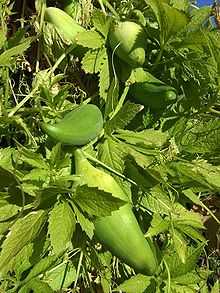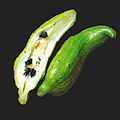Caigua
| Caigua | |
|---|---|
 | |
| Scientific classification | |
| Kingdom: | Plantae |
| (unranked): | Angiosperms |
| (unranked): | Eudicots |
| (unranked): | Rosids |
| Order: | Cucurbitales |
| Family: | Cucurbitaceae |
| Genus: | Cyclanthera |
| Species: | C. pedata |
| Binomial name | |
| Cyclanthera pedata (L.) Schrader | |
| Synonyms | |
|
Momordica pedata L. | |
The caigua (pronounced kai-wa) is a herbaceous vine grown for its edible fruit, which is predominantly used as a vegetable. Caigua is known from cultivation only, and its large fruit size as compared to closely related wild species suggests that the caigua is a fully domesticated crop. Its use goes back many centuries as evidenced by ancient phytomorphic ceramics from Peru depicting the fruits. It is also known as caygua, caihua, cayua, achojcha, achokcha, slipper gourd, lady's slipper, sparrow gourd (Chinese: 小雀瓜; pinyin: xiǎoquè guā), pepino in Colombia, stuffing cucumber in English, korila in the Philippines, and olochoto and kichipoktho in Bhutan.
Origin and distribution
Domesticated in the Andes and traditionally distributed from Colombia to Bolivia, the caigua is now grown in many parts of Central America and also in parts of the Eastern Hemisphere tropics. For example, caiguas are very popular in northeastern India, Nepal and Bhutan.[1] The Moche culture had a fascination with agriculture and displayed this in their art. Caiguas were often depicted in their ceramics.[2]
Food uses
Typically, the immature fruits are eaten cooked, raw in salads, and pickled. The caigua has a subtle flavour similar to other edible cucurbit fruits. The fruit has a large cavity in which the seeds develop, and this can be filled with other foods to make caigua dishes. This may have inspired the local Andean name pepino de rellenar ("stuffing cucumber"). The young shoots and leaves may also be eaten as greens.
Phytochemicals
The ripe fruit contains phytochemicals such as peptins, galacturonic acid, resins, lipoproteins and various steroidal compounds.
Images
-
Flowers
-

Fruits
-

Cross-section
-

Seeds
-

Caigua represented in a Moche culture ceramic
References
- ↑ "Cyclanthera pedata: from the Andes to the Himalayas". Crops for the Future.
- ↑ Berrin, K. & Larco Museum (1997). The Spirit of Ancient Peru: Treasures from the Museo Arqueológico Rafael Larco Herrera. Thames and Hudson, New York.
External links
| Wikimedia Commons has media related to Cyclanthera pedata. |
- Multilingual taxonomic information from the University of Melbourne
- Crops for the Future: Caigua (Cyclanthera pedata)
